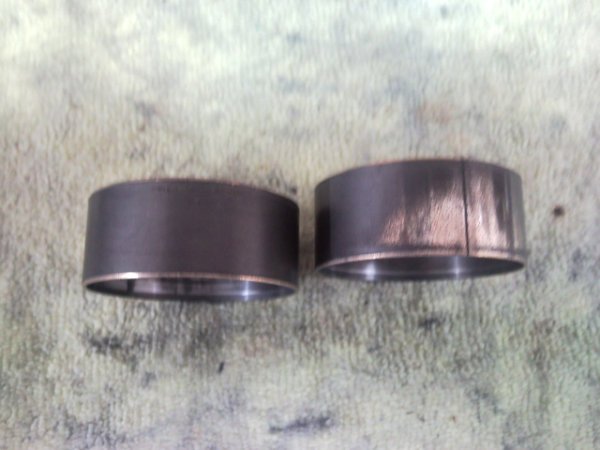Ross, As soon as you open the Penske shock you should replace all the rubber wear parts. On any shock, the shaft seal should be replaced because it is a high wear part. In the case of the Penske, that seal is a round section Viton O-ring and after enough wear it will let all the oil out, even all at once

. The shaft seal cost about $1. There is also a shaft scraper that helps keep junk out of your shock, another couple bucks. On an Ohlins shock, the seal is a little different design, it is a quad ring or 4 sided O ring that has more contact area and that ring is backed up by a Teflon backer ring that is designed to prevent extrusion of the o ring at extreme pressures. The Ohlins shock also has a shaft scraper. On your Penske shock, there is also a shaft bushing that is a standard Garlock design (basically steel coated in Babbitt and then Teflon) but those things will often last many, many miles. Stationary o rings don't have to be replaced if they have not compression set but since they are so inexpensive, I replace all of them. Some other key wear items in the Penske include the piston band expander ring which is a thin section o ring that provides outward pressure on the carbon filled Teflon wear band on your damper piston and the floating piston O ring that is also a sliding part.
It makes sense to take apart your valving stack since all the shims can trap some debris and potentially case the shock not to perform as well as it could. With the shims off, I check each one for wear and to see if they have any deformation or burning on them,. If there are problems, the shims should be changed (again this is a problem we see with high mile shocks that have not been cared for). After all that, I run the shock on a damper dynamometer to ensure proper function.
A typical rebuild of a shock like the your Penske, most shops should charge you about $120-$175 total to do all this work (that assumes the shock is in decent condition and did not need major parts). Really a quite good value I think. It is possible to carry out that kind of work as a home mechanic with some determination and a few special tools. For the time it takes, it is likely a lot more practical to send your shock to a good specialist shop that is properly equipped unless you are really into the DIY experience.
When your shock is out, clean and inspect the bearings in your linkage system, a little cleaning and grease and that stuff will last incredibly long. If bad, it really isn't too bad to replace the bad parts. Don't forget your forks and steering bearings. The suspension components are what make the bike feel and work great.
Compared to a car shock that cost $30 at K-mart the high end motorcycle dampers are like some NASA or Formula one part. We built a set of shocks for my sons car that he uses for Autocross. Lots of those enthusiasts will spend $1000 a corner to have Ohlins or Penske shocks on their cars as well. At least we only need one





